The mushroom buttons each moist morning brings
Like spots of snow on the green tawney rings
And fuzz balls swelld like bladders in the grass
Which oft the merry laughing milking lass
Will stoop to gather in her sportive airs
And slive in mimickd fondness unawares
To smut the brown cheek of the teazing swain
Wi the black powder which their balls contain
Which feign offence at first that love may speed
Then charms a kiss to recompense the deed.
John Clare, from ‘October' in The Shepherd’s Calendar
Felled tree trunk with mushrooms in Crow Wood, 23 October 2023.
Hello lovely friends, and welcome to this full moon in Taurus edition of Bracken & Wrack. Not only is this the last full moon of the eclipse season, which tends to bring great change, but it is also a partial lunar eclipse, visible tonight in many parts of the world including the UK. A lunar eclipse is often called a Blood Moon, which is a resonant name this month, as we shall see.
In this issue:
Full Moon Names
Hallowtide Poems
October Treasures
Devil on a Halter
The Lucifer Lantern
St Bega’s Pumpkin, Carrot & Sweet Potato Soup
After the Harvest Moon comes the Hunter's Moon, in the optimum month to hunt summer-fattened deer and other animals unable to hide in the bare fields. Like the Harvest Moon, the Hunter's Moon is also especially bright and long in the sky, giving hunters the opportunity to stalk prey by night. The full moon rises at an early hour for several nights in a row both in September and October, bringing plenty of soft illumination for harvesting and then hunting.
As we’ve learned, each moon name was traditionally applied to the entire lunar month in which it occurred, rather than to just the full moon itself. The Harvest Moon and Hunter’s Moon are unique in that they are not tied to a particular month. Instead they are linked to an astronomical event, the autumn equinox.
The Harvest Moon is the full moon that occurs closest to the date of the autumn equinox, so it can occur either in September or October. This year the full moon following the autumn equinox fell on 29 September, making that one the Harvest Moon. Similarly, the Hunter’s Moon is the first full moon to follow the Harvest Moon, meaning it can occur in either October or November. Are you confused yet?! Most commonly the Hunter’s Moon does fall in October, which is how I’ve always thought of it, and I instinctively relate the Hunter to Orion, as his constellation regains its position in the heavens at this time of year.
Other names for the Hunter’s Moon are the Sanguine or Blood Moon, either associated with the blood from hunting or perhaps with the colour of the changing autumn leaves. There is also Drying Rice Moon, a Dakota name, which describes the post-harvest process of preparing rice for winter. Falling Leaves Moon is a self-explanatory name given by the Anishinaabe tribe. Freezing Moon (Ojibwe) and Ice Moon (Haida) acknowledge the falling temperatures of this period. Then there’s Migrating Moon (Cree), referring, of course, to birds flying south to warmer climes. Other names include the Travel Moon and the Dying Grass Moon. Michael Howard in Liber Nox runs with Hunter’s Moon, while Fiona Walker-Craven in 13 Moons chooses Blood Moon.
Now, in time-honoured fashion perhaps we should have a go ourselves. It’s not easy when the name Hunter’s Moon is so resonant and so deeply ingrained. It’s established enough that its first known citation is in the Oxford English Dictionary of 1710. But looking around me here in north Norfolk I’m thinking Cobweb Moon or Fly Agaric Moon. How about you? What are you noticing about the season where you are?
Fly Agaric in the woods by the stream, 31 October 2022.
I learn the bones
of oxen
hearts of sheep
words
for walking cows
between fires
my head echoes
with the names
of a hundred gods
I talk to the dead
I give child
I heal with mistletoe
and smoke of mosses
use the moon
to choose ploughing days
bright stars
for hay cutting
I see storm and sheep-rot
in the drip
of pig’s blood
on pebbles
a wheel of rooks
says hollow corn
I speak in the oak grove
of our far times
my secrets
keep the tribe alive
Victor Tapner, ‘Witchman’s Song', Flatlands
Sunrise from my bedroom window, 29 October 2021.
Three years ago:
Well here we are on the day before All Hallows’ Eve ... a quiet grey day in this little corner of Norfolk. A couple of days ago I picked the last of the dahlias (not that there have been many!) and found a lustreware jug for them that’s been lurking unused in the dresser. Then there were the last of the straggling nasturtiums .... and a trio of pumpkins from neighbours across the lane ... and suddenly everything glowed with that elusive golden late-October light, just for a moment.
Two years ago:
Blackthorn, hawthorn, wild parsley, honesty, ivy berry, conker-case, sea-washed bone, an oyster shell shaped like a crow’s wing, and of course a silver sliver of moon ….
This morning I decided it was high time to seek out some scraps of autumn along the lane and place them, glowing in their russet glory, on my favourite copper plate. What a difference it’s made to the cottage sitting room, taking just a few minutes to collect and arrange. Honestly, when I designed the River Song candle my dreams were full of watery autumn equinox magic and the opaline surface of the stream. But with the approach of All Hallows’ it seems to have taken to its October persona like, well, like a duck to water.
Even now this landscape is assembling.
The hills darken. The oxen
sleep in their blue yoke,
the fields having been
picked clean, the sheaves
bound evenly and piled at the roadside
among cinquefoil, as the toothed moon rises:
This is the barrenness
of harvest or pestilence.
And the wife leaning out the window
with her hand extended, as in payment,
and the seeds
distinct, gold, calling
Come here
Come here, little one
And the soul creeps out of the tree.
Louise Glück, ‘All Hallows’
Not just for Halloween, here is a rather gorgeous devil being led on a halter by the equally gorgeous St Juliana. Apparently it’s a rare image, and this medieval screen a few miles from here is hardly restored, unlike most.
The Lucifer Lantern
While I love the glow of an orange pumpkin at Halloween as much as the next person, and of course they are far easier to carve into than the traditional swedes or turnips, there is something to be learned from the old ways.
It has to be said that I do remember with great fondness our pumpkin lantern that my brother and I made each year with the help of our mum. We would set it in the window (this was before the days of the Trick or Treat revival) and I would revel in the seasonal scent of burnt pumpkin as the tea light slowly scorched the inside of its stalky lid. It would be kept for Guy Fawkes Night, the lid a little dried out and not fitting quite so closely, but still serviceable enough to illuminate the garden fireworks evening. This was always presided over by my dad who was clearly the only person responsible enough to be allowed to dish out the sparklers or light the blue touch paper and retire.
My mum would have already made her special crunchy honeycomb bonfire toffee which we devoured in the dark, all spiky corners where it had been broken into irregular chunks. Heinz tomato soup and jacket potatoes to warm up afterwards and the seasonal observance was complete.
(We won’t mention the year that my brother managed to burn a hole with a sparkler in my Nana’s fur coat.)
So, what of these ‘old ways’? Before being lured by the delights of the pumpkin I vaguely remember having swede lanterns - always hollowed out by my mum as they would have been far too tough for little hands - with string or wire handles knotted around them. In the Victorian days of the Yorkshire wisewoman whose advice we often draw on here at Bracken & Wrack, it would have been turnips or swedes all the way. This I knew already, but what I hadn’t realised, and what seems interesting in the light of other All Hallows’ lore, is that this lantern was sometimes called the Lucifer Lantern.
This is what the wisewoman, speaking through her granddaughter, has to say:
‘When you make the Lucifer Lantern, remember that it is a turnip because that vegetable which grows from clay and will rot back into clay is a symbol for our own bodies; but the rushlight or candle inside it is eternal spirit which cannot die. The triangles you cut for the moth, the nose and the eyes are sigils of our earthly self aspiring heavenward like incense. As you cut them, intone to yourself as a charm that you will see no evil, hear no evil and speak no evil all the year through, and think upon the seven sacred apertures in your skull through which you perceive and take of the Elixir which is Life. The seven days of the week correspond to these, and the weekly cycle of the year which is 52 weeks. Numerologically speaking, 52 is 5 + 2 which again equals seven; and the Gods and Angels of the inner planets are seven. All is sacred.
‘The Lucifer Lantern is to be set upon the table as a centrepiece for the delight of your guests. On the next day, old New Year’s Day, you must bury it deep, and bless the spot, to show your allegiance with the soil of Mother Earth which nurtures you.’
Much food for thought here (literally, if you eat the scooped out turnip!). For example, it hadn’t occurred to me that the symbolism of a pumpkin is subtly different from that of a root vegetable. And I can imagine the burial of the lantern being a very profound experience. I may try it.
I’d love to hear about Halloween customs you remember from your own childhood!
PS: Obviously I still celebrate All Hallows’ with a carved pumpkin and delight in breathing in the heady scent of the burned lid. No fur coats here, of course. My grandmother with her larger-than-life presence would have been 120 this year on Valentine’s Day.
Pumpkin lantern and witch ball, 31 October 2021
St Bega and the Snow Miracle
St Bega’s Feast Day, according to the list of saints’ feast days I consulted, is on 31 October. A bit of digging revealed that a manuscript discovery of the last few decades altered the probable date of her death - and therefore her feast day - to 7 November, which is when it is celebrated in the places where there is a devotion to her. But both dates fall during this liminal Hallowtide period so I definitely feel she’s a worthy Samhain Saint.
I’m interested in Bega, partly because she gave her name to one of the famed bells of Crowland Abbey; one of the smallest, paired with that of my favourite St Pega. I suspect Bega was chosen for this honour somewhat randomly, for the less-than-devout reason that her name rhymes with Pega’s. But I’m hoping that my research will lead to a bit more clarity about that.
Bega is also known as Bee, and the centre of her cult was - and is - around the town of St Bee’s on the Cumbrian coast in the north east of England. I thought I would just write a little piece about her before sharing with you her soup recipe, but as I started looking into her legend I realised I could all too easily get carried away and write a whole essay. There are some fascinating folk stories about her, including the Snow Miracle when snow fell everywhere except for the area inside her monastery’s grounds. But those will have to wait until another day, given the constraints of space in this newsletter.
Meanwhile I offer you this soup, which I am absolutely sure that Bega would have loved to warm her hands around in her windswept hermitage. PS: As an Anglo Saxon princess, I’m not entirely sure that Bega would have had access to either pumpkin or sweet potato, but passed-down recipes evolve through the centuries, don’t they ;)
St Bega’s Pumpkin, Carrot & Sweet Potato Soup
This is a shameless improvisation on a Deliciously Ella recipe, devised while making use of what I could scrape together in the kitchen. The soup is vegan and gluten free and it turned out so surprisingly tasty that I thought I’d share in case you’d like to try it too.
I’m afraid the recipe has ended up being one of those vague ones without quantities, which I hope you won’t mind. The pumpkin I used was the flesh I scraped out of my lantern, but it’s quite a small one and I thought I needed to add something else. Hence the carrots and sweet potato.
Scrape out the pumpkin seeds, rinse and tip into a roasting tin. Roast at 200 degrees C with salt, a good sprinkle of ground cumin and olive oil, until crisp and brown. Remove and put aside for the garnish, then place into the tin a couple of sweet potatoes, diced, three whole cloves of garlic and an onion cut into chunks. Toss with olive oil, salt, cumin and some chilli flakes and roast at the same temperature, turning as necessary, for around 25 minutes.
Meanwhile, steam or boil in a little water the scooped out pumpkin flesh and a few carrots, peeled and sliced.
When the roasted veg is done, add to a blender with the steamed pumpkin/carrots and enough almond milk (or other milk) to give the thickness you like. You could also include a little of the boiling/steaming water.
Blend until smooth, then pour back into the pan and heat to serving temperature. Serve scattered with spiced roasted pumpkin seeds if wished.
I have to say I was amazed by the depth of flavour considering there are so few spices involved. It’s the roasting that does it ;)
St Bega’s Pumpkin, Carrot & Sweet Potato Soup
And time may rule the bone and the feather, the leaf and the skin. But time has no call on the singing and on the song, time has no call on to whom you give your heart, and where the hare makes her bed, has no tenure over hope, over dreaming, over even the beginning and the end.
This is the work of love.
Lay down my love, lay down, open your hand, you are not marooned. I am waiting, I am on the other side of the hill. Here. Every spoken word of love is held, is alive, remains.
Peter Owen Jones, from ‘The Robin Speaks of Death’ in Conversations with Nature
Reading Hallowtide poems and quotes around a fire to participants in a Samhain guided art/archaeology walk. Hot chocolate and Soul Cakes followed :) My late husband Trevor and me in a field at Salle, Norfolk.
Full Moon cobweb on the heath, 28 October 2023.
Until next time,
With love, Imogen x




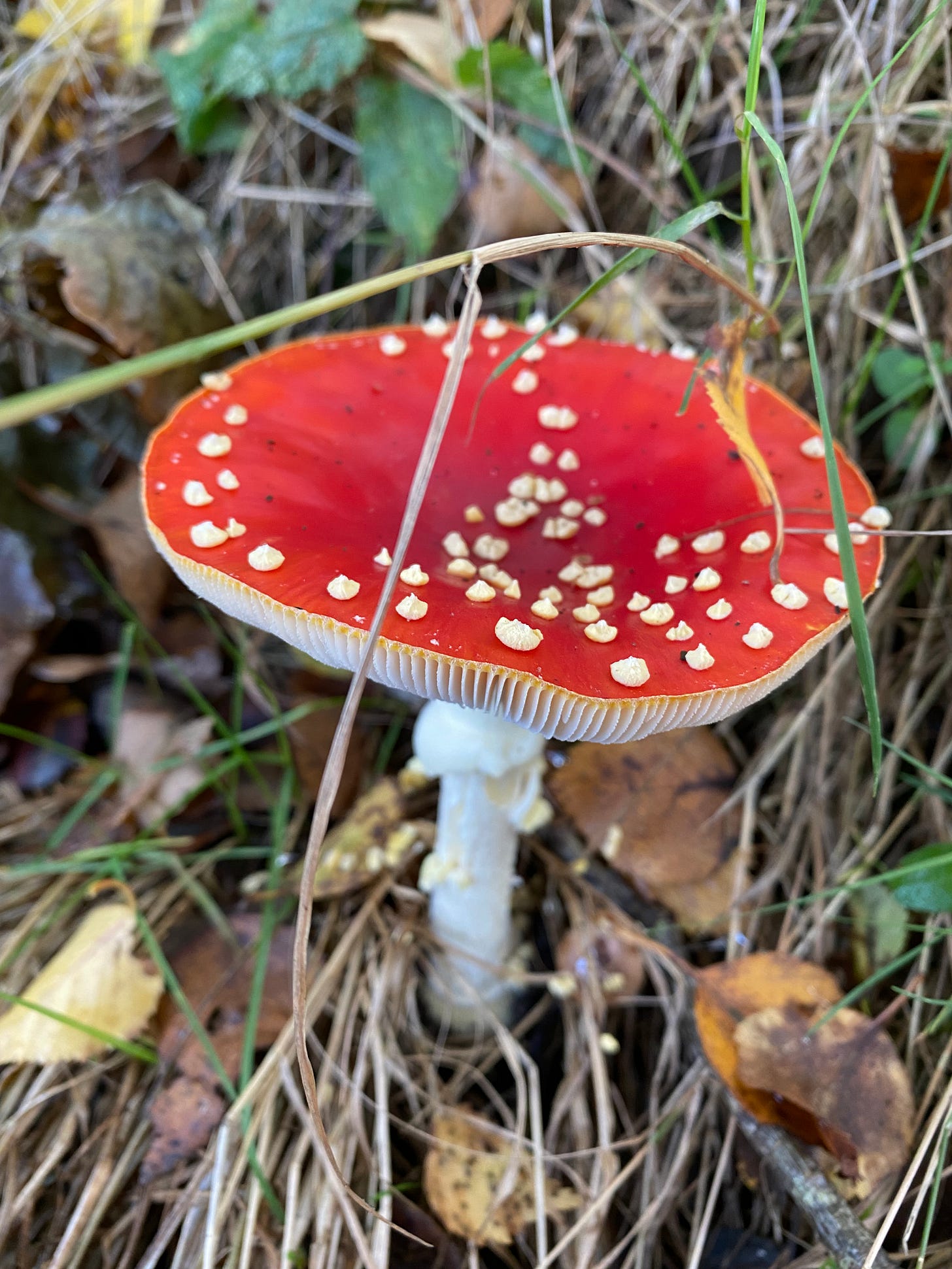
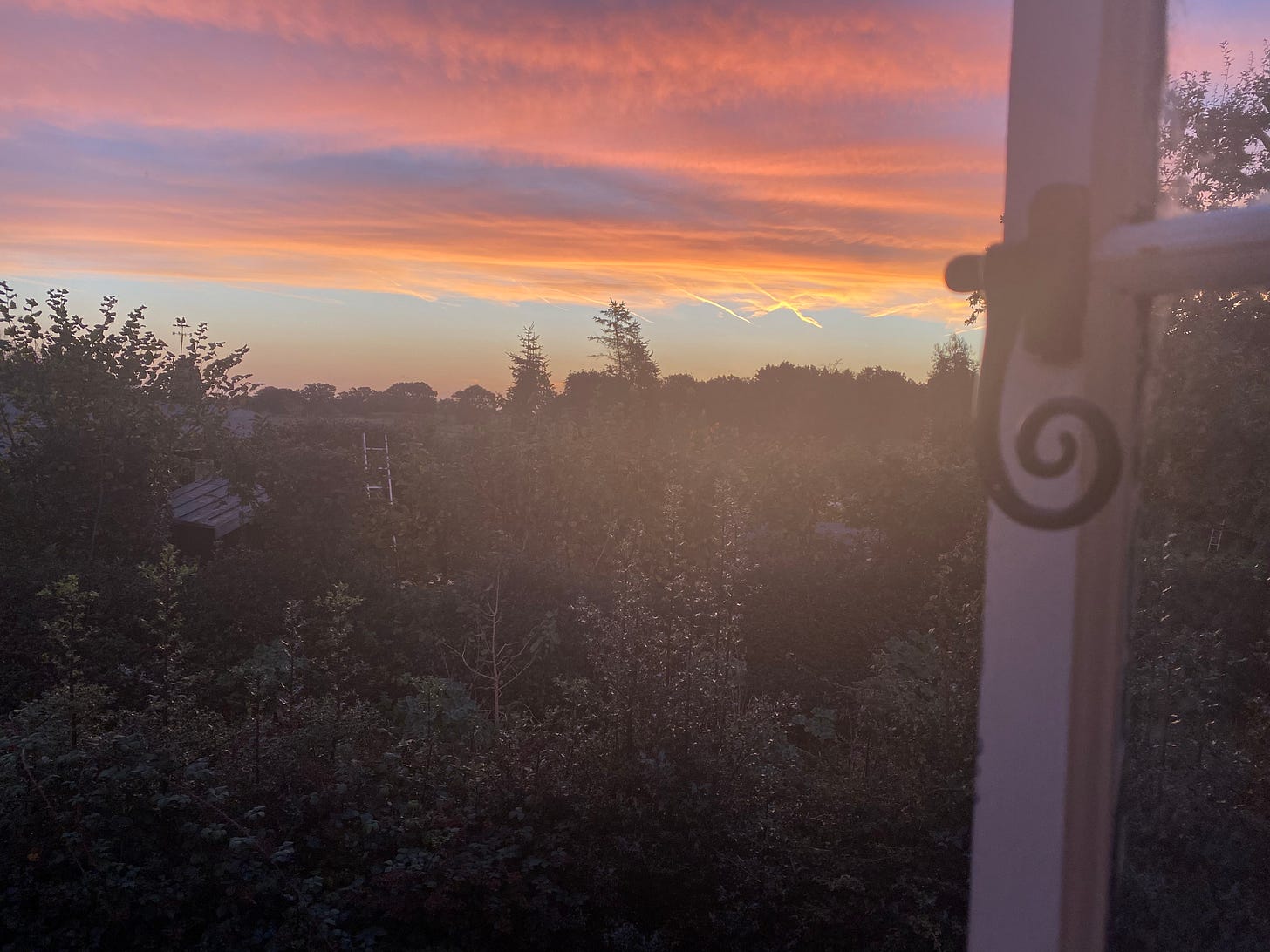
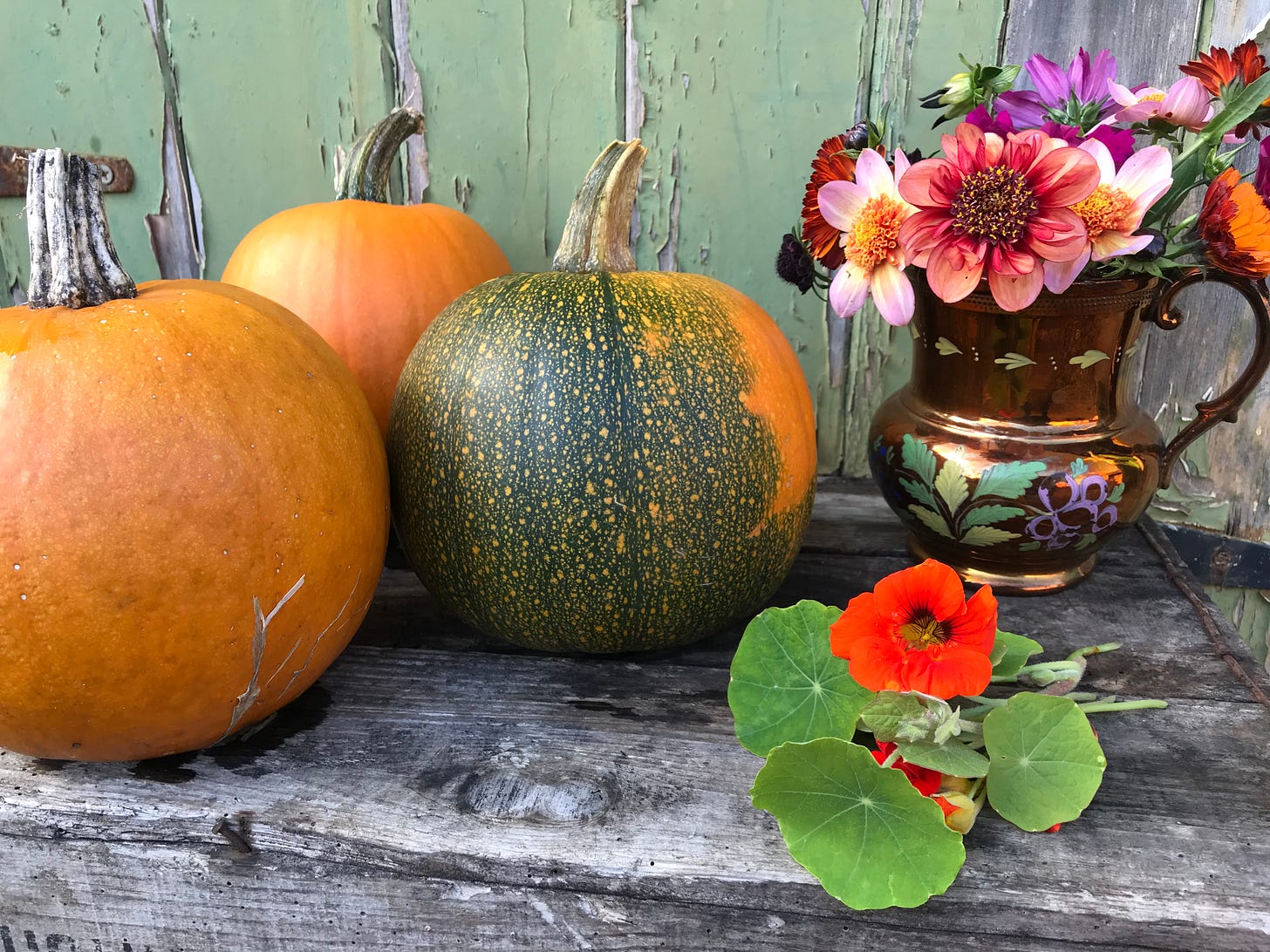
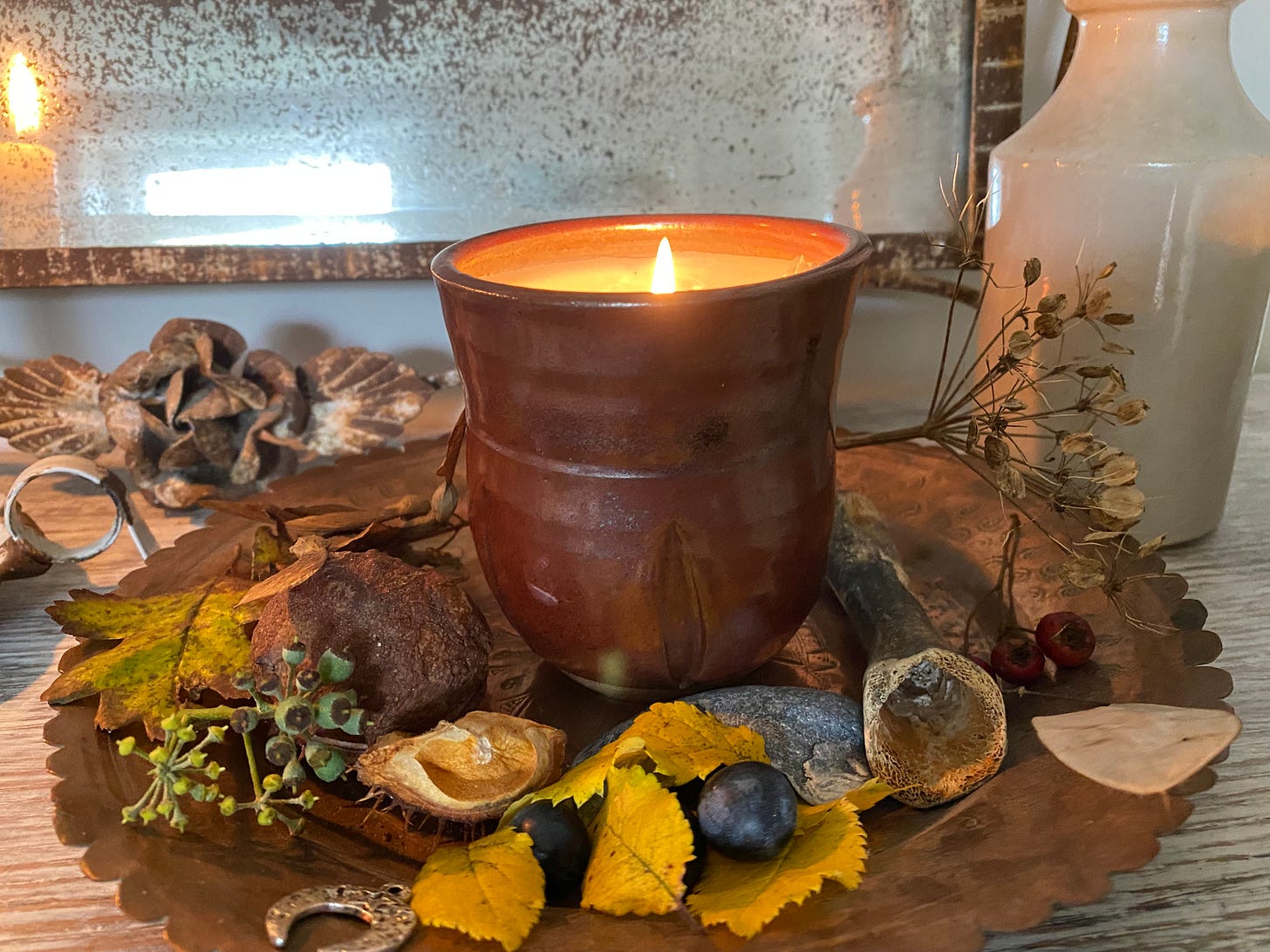
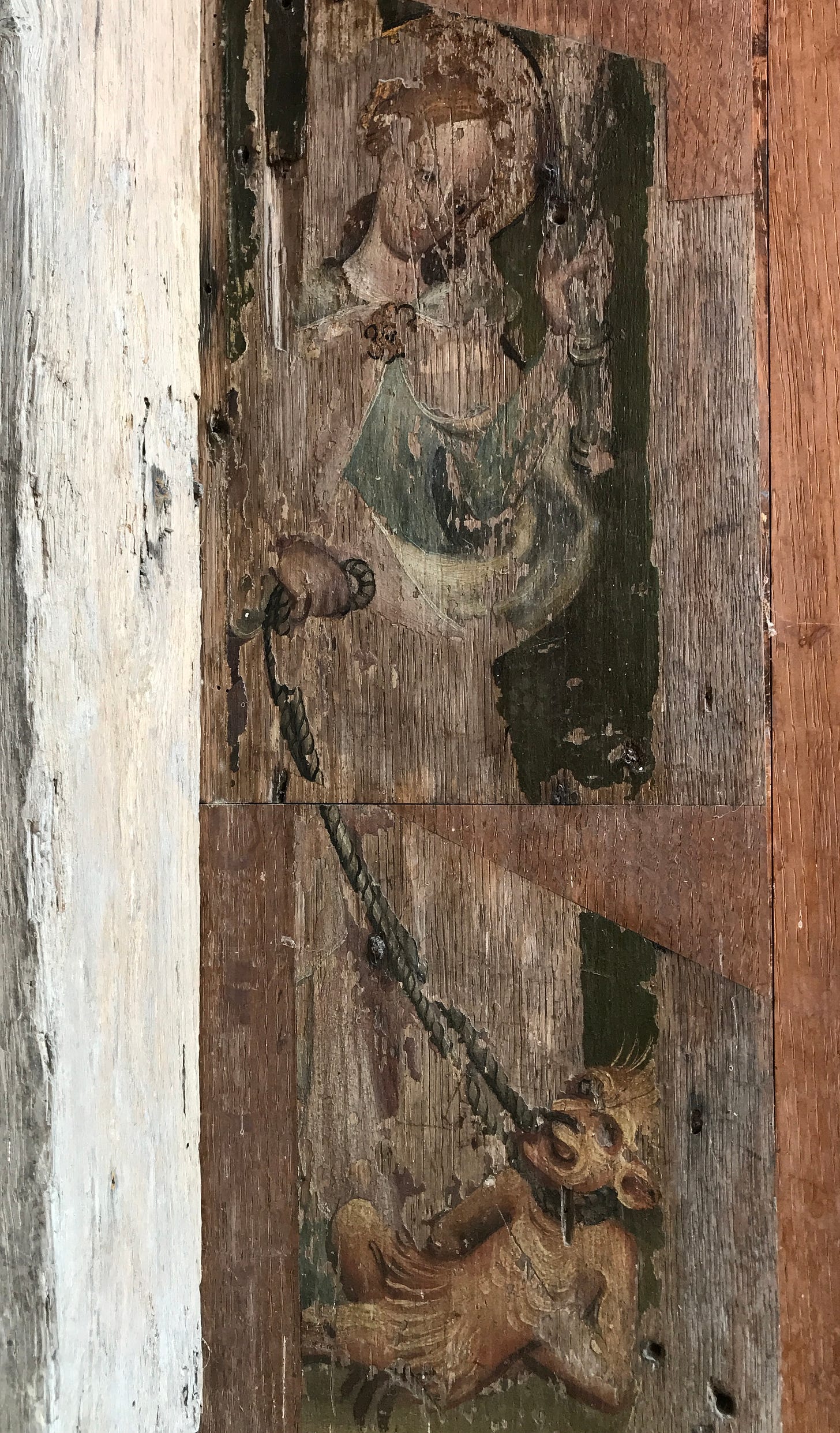
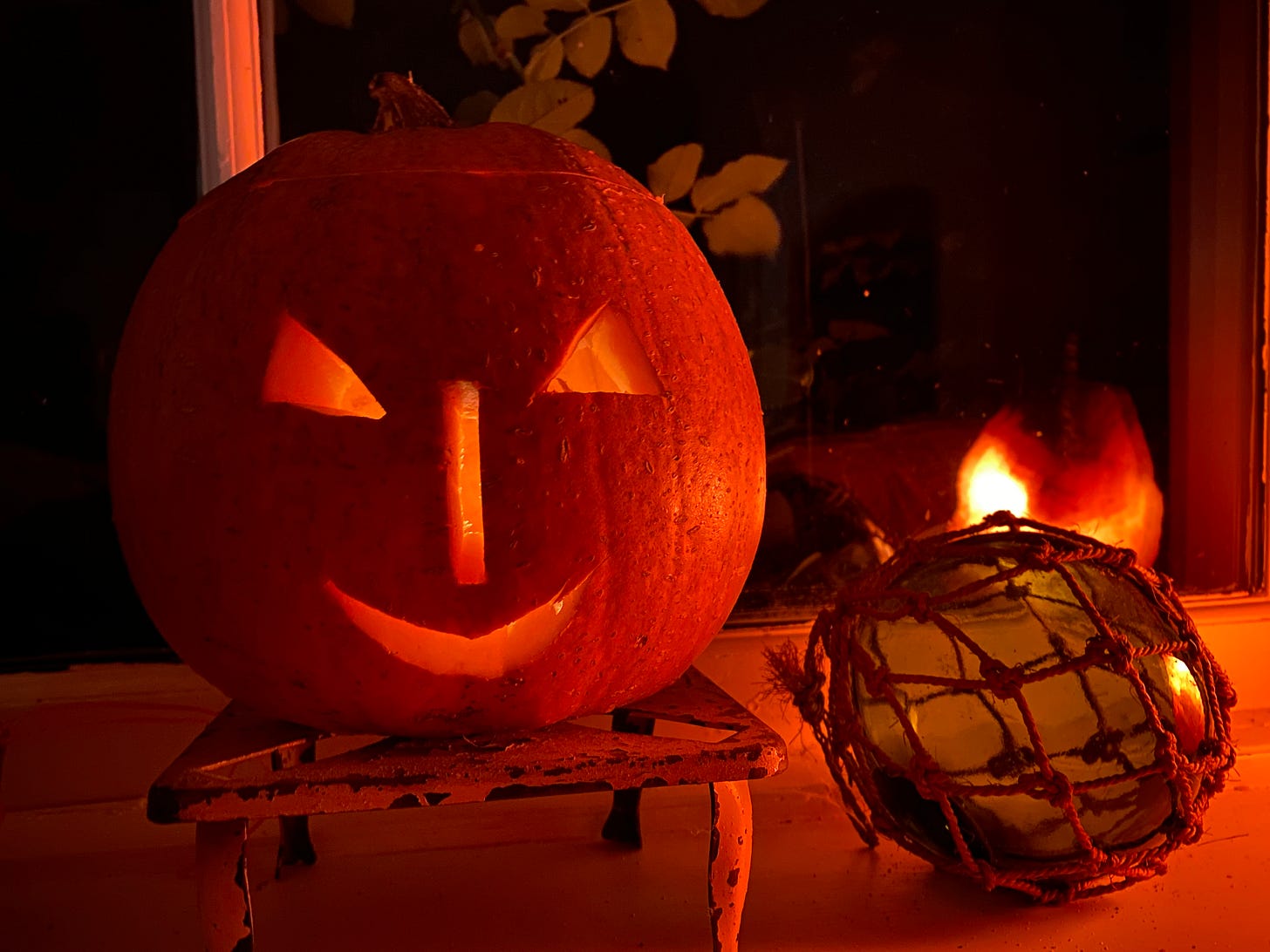

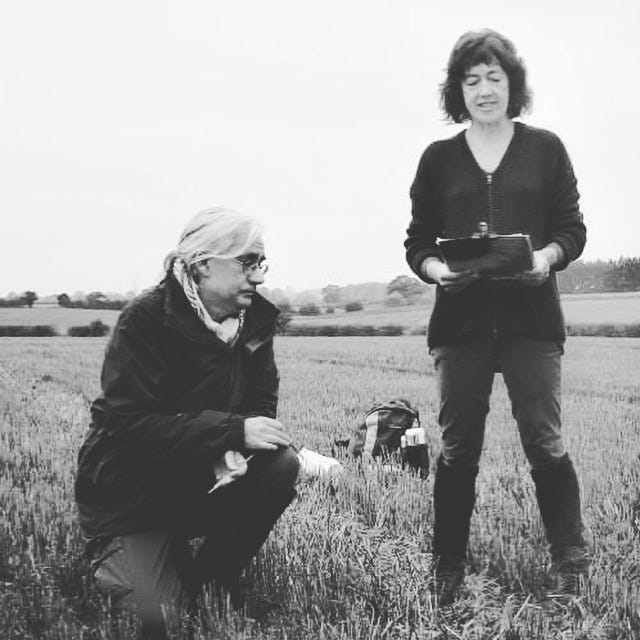
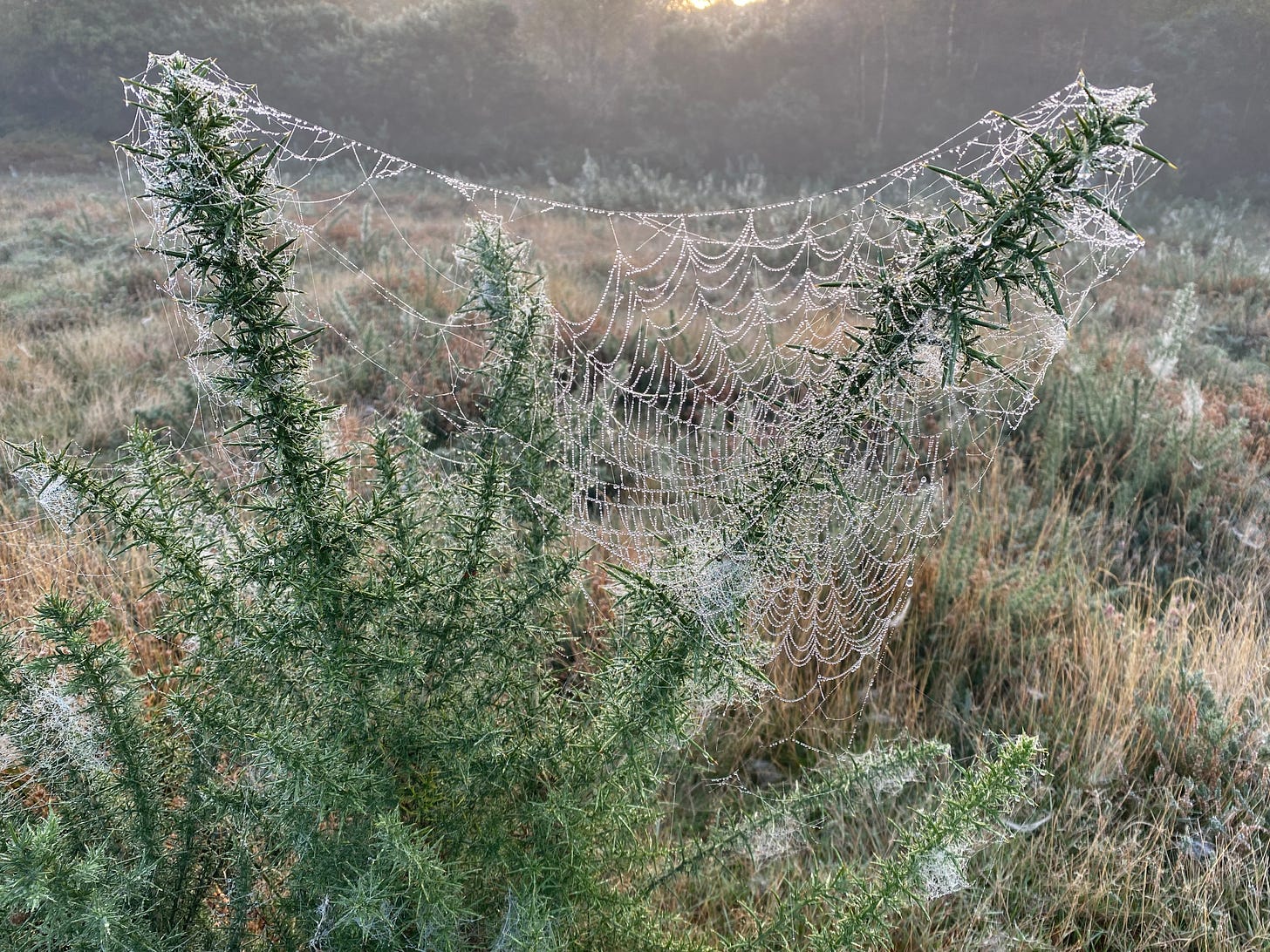
Thank you! I loved reading this! I remember our first Halloween when we were living in Ireland. We were the only family in our neighborhood with a Jack O Lantern carved from a pumpkin! However, it did prompt my neighbor across the street to carve Swedes to put in her window! My boys went with my friend and her children to the village Bonfire and later they did some trick or treating. My boys came home with a huge bag of peanuts ( monkey nuts) and fresh fruits! Seems we were also the only neighbors handing out sweets to the trick or treaters which explained why we ran out of candy so early! Lol!
Beautiful Imogen. The last quote and the photo of you and Trevor made me well up. I did not know about the origins of the three triangles cut into the pumpkin for the nose and eyes. I assumed it was the easiest shape to manage. So enlightening!
The soup sounds delicious and I will definitely try it. Soup season is long! Traditionally in our family, I have made Three Sisters Soup on Halloween, another delicious recipe I’d be happy to share